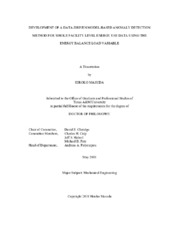| dc.description.abstract | The continuous monitoring of building energy use provides useful feedback to building owners and operators to achieve persistent energy efficiency and to make important engineering and financial decisions. The practice of managing the quality of metered data is essential to the successful utilization of energy data because metered energy data often contain errors and biases. This dissertation develops a method for automatically detecting anomalies in whole-building energy use data. The method can assist time-consuming and expensive tasks in monitoring and managing energy use data collected from a large portfolio of buildings. The method uses a variable called the energy balance load (EvBL), which is calculated from separately metered electricity, cooling, and heating energy use data. Anomalies are detected based on the distance between the EvBL value that is predicted by a data-driven reference model and the actual EvBL value. For the EvBL reference model, a simple regression model with weather variables is used so the model can be applied to various types of buildings with minimal information.
Updating reference models to account for the dynamic use and operations of buildings is a challenge. To address this challenge, this dissertation develops an anomaly detection method using the adaptive recursive least squares (RLS) filter as a reference model estimator and the standardized cumulative sum (CUSUM) test as a change detector. In the application to actual data, the new method demonstrates the ability to detect anomalies in a timely manner. The measurement bias in the chilled water use, caused by a drift of the temperature sensor reading, was detected on the fourth day after the temperature began to drift. Furthermore, the start of a disabled time schedule for the heating, ventilation, and air conditioning (HVAC) systems was detected on the seventh day, and the change-back to the previous schedule was detected on the second day. Both the physical interpretation of the EvBL model parameters and the sensitivity and uncertainty analysis on the key parameters are presented such that they can be used as aids to warn analysts against physically impossible reference models. | en |


